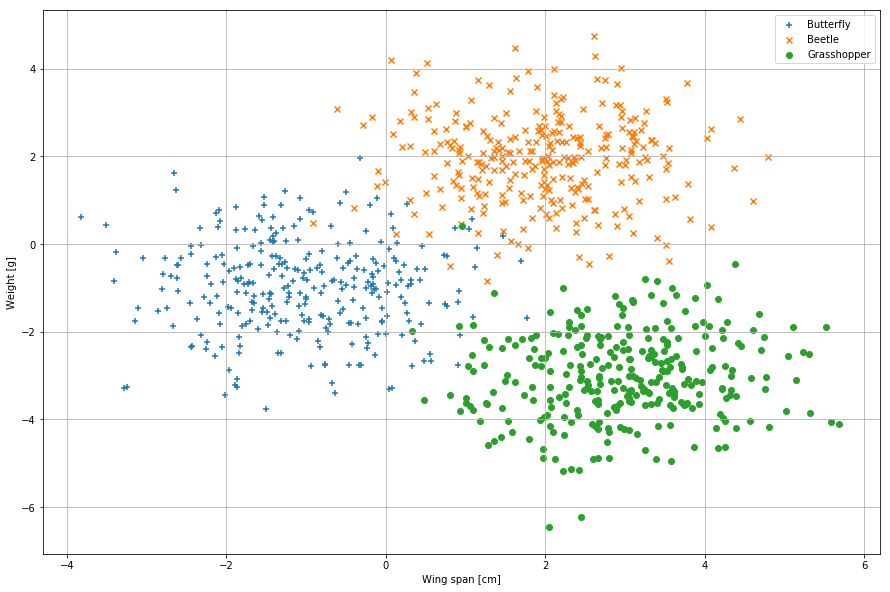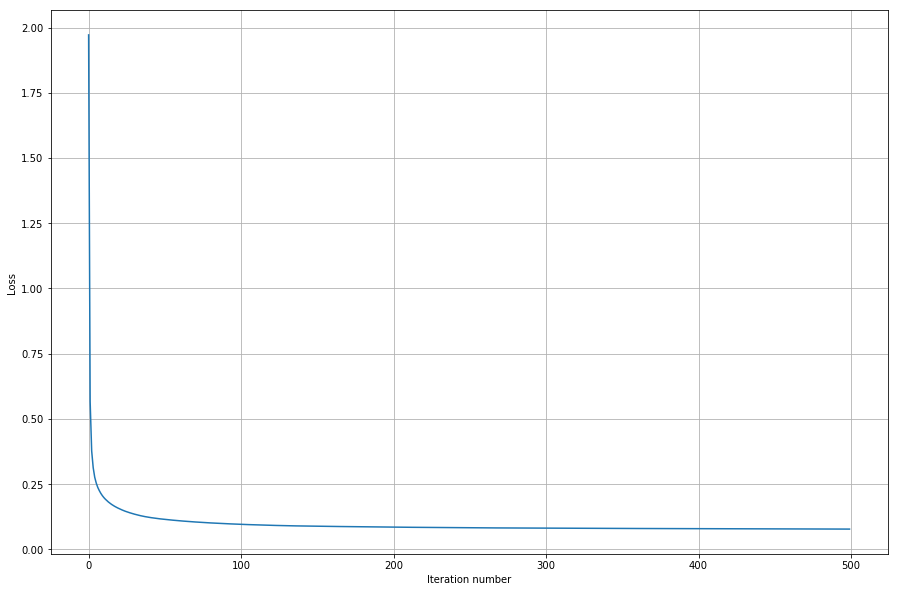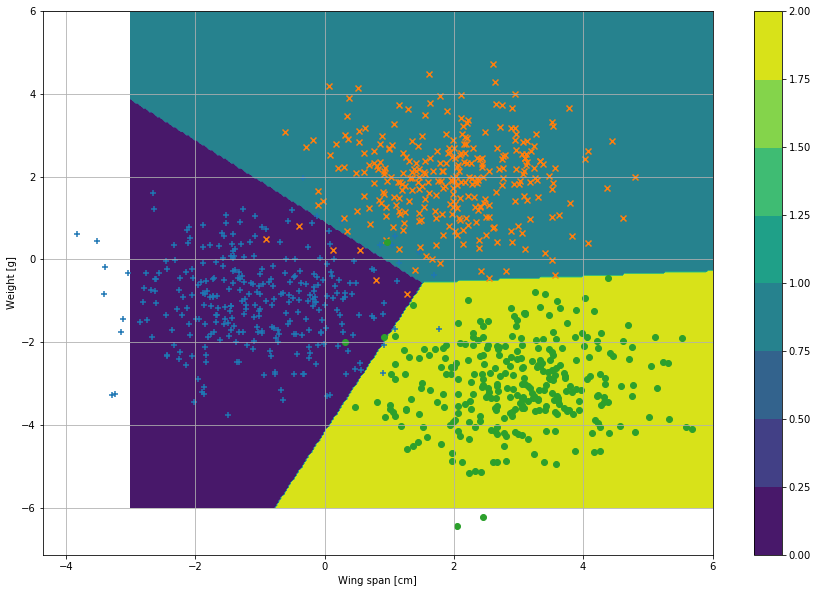Neural Networks journey: multiclass categorization
TL;DR
In this post we’ll cover multiclass categorization problem using support vector machine classifier. All the code in this post is written in Python, version 3.6. I’ve gathered most of the used material from here. It’s very good site, if you want to check out more example and theory.
Multiclass classifier
Before going into neural networks, I thought we should cover multiclass classifier first. In the previous posts we created a binary classifier, which was able to classify two categories (classes): bees and hornets. But what if we want to classify multiple classes, f.ex: lady bugs, bees, butterflies etc. As before, let’s create some data first, so we can visualize the problem.
%matplotlib inline
import numpy as np
import matplotlib.pyplot as plt
import matplotlib
from IPython.display import Image
from IPython.core.display import HTML
matplotlib.rcParams['figure.figsize'] = (15.0, 10.0)
num_of_points = 300
x1 = np.random.normal(-1, 1, num_of_points)
y1 = np.random.normal(-1, 1, num_of_points)
n1 = np.zeros(num_of_points)
x2 = np.random.normal(2, 1, num_of_points)
y2 = np.random.normal(2, 1, num_of_points)
n2 = np.zeros(num_of_points)
n2[:] = 1
x3 = np.random.normal(3, 1, num_of_points)
y3 = np.random.normal(-3, 1, num_of_points)
n3 = np.zeros(num_of_points)
n3[:] = 2
x = []
y = []
n = []
for ni in [x1, x2, x3]:
x.extend(ni)
for ni in [y1, y2, y3]:
y.extend(ni)
for ni in [n1, n2, n3]:
n.extend(ni)
train_input = np.array([x,y]).T
train_output = np.array(n)
perm = np.random.permutation(train_output.shape[0])
train_input_shuffled = train_input[perm]
train_output_shuffled = train_output[perm]
plt.scatter( x1, y1, marker="+", label="Butterfly")
plt.scatter( x2, y2, marker="x", label="Beetle")
plt.scatter( x3, y3, marker="o", label="Grasshopper")
plt.xlabel("Wing span [cm]")
plt.ylabel("Weight [g]")
plt.legend()
plt.grid()

As you can see there are three clusters, each representing one bug. We’ll use the same tools as before, but we only need a proper loss function for this: Support vector machine
Support vector machine
Multiclass classifier
For multiclass classifier there are couple of options, f.ex. support vector machine (SVM) or softmax but we’ll use SVM. SVM is defined as ( ref ):
\begin{equation} L_i = \sum_{j\neq y_i} \max(0, s_j - s_{y_i} + \Delta) \end{equation}
in which is our linear function: \begin{equation} s_j = f(x_i, \theta, b)_j = (\theta x + b)_j \end{equation}
Looks intimidating, how do we use it? represents just the score of the function and and represent indeces. is special case and represent the correct index (or the correct class). Let’s say we have input vector, which has six (6) elements. We’ll calculate the score using linear function and the output vector has (4) elements, which represent our categories. Let’s say the correct class is index 1 and use it to calculate the loss:
input_vector = np.array([5.2, 1.0, 6.356, 10.1, -4.45, 8.20]).T
theta = np.random.rand(4,6)
beta = np.random.rand(4)
yi = 1
delta = 1
scores = np.dot(theta, input_vector) + beta
print("Score vector: {0}".format(scores))
s_yi = scores[yi]
Li = 0
for j in range(len(scores)):
if j == yi:
continue
score = scores[j] - s_yi + delta
if score > 0:
Li += score
print("Score: {0}".format(Li))
Score vector: [ 16.77187651 19.85518302 22.05848935 18.11694353]
Score: 3.203306333209401
Now do note, that in the logistic regression we got only one output value for given set of inputs. Multiclass classifier produces a array, which contains a score for each class. In the example we had a input array which had 6 values and using dot product we got score array which had 4 values or classes. The highest score represents the best guess. When we make a prediction, we select the class which has the highest score using argmax -function.
Loss function represents the fitness of our fit, or the quantity of data loss. But there lies a bug in our code. Suppose we want to minimize the function, which is . Now the problem arises if is converges to and that might not be our preferred fit. We’ll need to add a penalty for the too, and in this case, we can use regularization penalty . One of the most common penalties is the L2 norm:
\begin{equation} R = \sum_i \sum_j \theta^2_{i,j} \end{equation}
Now if we add this to loss function, and suppose we have number of points to fit our model, the total loss function is now:
\begin{equation} L = \frac{1}{N}\sum_i L_i+ \frac{\lambda}{2} R(\theta) \end{equation}
in which is the regularization strength and is the number of points. It’s also common to see the in front of the regularization so, so that the derivative will cancels it out. We’ll need the gradient of our loss function for the stochastic gradient algorithm, so here it is:
\begin{equation} \frac{\partial L}{\partial \theta_n} \rightarrow \frac{1}{N}\frac{\partial}{\partial \theta_n}(\sum_i L_i) + \frac{\lambda}{2} \frac{\partial}{\partial \theta_n} (\sum_i \sum_j \theta^2_{i,j}) \end{equation}
Now in order to derivate the we need to use the chain rule:
\begin{equation} \frac{\partial L}{\partial \theta_n} = \frac{1}{N} \frac{\partial L_i}{\partial s_i}\frac{\partial s_i}{\partial \theta_n} + \lambda \theta \end{equation}
Now derivating presents us two cases: one where we derivate and one where we derivate
is just a function, which just evaluates if the inside is greater then zero function produces value 1 and if not, function produces 0. Now that function is quite long, so let’s make an alias for that:
\begin{equation} \nabla L_i = \frac{\partial L_i}{\partial s_i} \end{equation}
and our final equation is:
\begin{equation} \frac{\partial L}{\partial \theta_i} = \frac{1}{N} \nabla L_i + \lambda \theta \end{equation}
Phew! We’re almost done! Here’s the code:
def svm_loss_function_and_gradient(theta, X, y, delta):
score_matrix = np.dot(X, theta)
theta_shapes = theta.shape
categories = X.shape[1]
n_points = X.shape[0]
L = 0.0
dL = np.zeros(theta_shapes)
# compute the loss and the gradient
for i in range(n_points):
# Select the correct score index
yi = y[i]
# Select score row and correct score
scores = score_matrix[i, :]
correct_score = scores[yi]
# Calculate the loss function
score_row = np.maximum(0, scores - correct_score + delta)
score_row[yi] = 0
L += sum(score_row)
# We want the indeces where score is more than zero
indeces = np.array(np.nonzero(score_row))[0]
# Add to gradient
for idx in indeces:
dL[:, idx] += X[i, :]
dL[:, yi] -= len(indeces) * X[i, :]
# Take the average for L and dL
L /= n_points
dL /= n_points
return L, dL
Fitting the model
In the model I’m not going to use vector separately, as presented in the equations. Instead I’m going to just add one column to the matrix and an array of ones to the initial X input matrix.
# Theta sizes
D = 3
h = 3
# Theta matrix
theta = 0.01 * np.random.randn(D, h)
# Shuffle the points and add one array
n_points, categories = train_input_shuffled.shape
extra_row = np.ones((n_points, 1))
X = np.hstack([train_input_shuffled, extra_row])
y = train_output_shuffled
# some hyperparameters
step_size = 1e-1
_lambda = 1e-3 # regularization strength
# gradient descent loop
num_examples = X.shape[0]
losses = []
loss_iteration = []
for i in range(500):
# evaluate class scores, [N x K]
scores = np.dot(X, theta)
# Calculate loss and gradient
L, dL = svm_loss_function_and_gradient(theta, X, y, 1.0)
# We do not want to add b array, so slice
dL[:, :-1] += _lambda * theta[:, :-1]
# Regularization penalty
reg_penalty = 0.5 * _lambda * np.sum(theta**2)
total_loss = L + reg_penalty
# Gradient update
theta += -step_size * dL
losses.append(L)
loss_iteration.append(i)
plt.plot(loss_iteration, losses)
plt.xlabel("Iteration number")
plt.ylabel("Loss")
plt.grid()

Our function converges to the best value quite fast, and I guess only 200 iterations would have been sufficient. Let’s plot our results!
num_points = 300
x_1 = np.linspace(-3, 6, num_points)
x_2 = np.linspace(-6, 6, num_points)
feed_forward_results = np.zeros((num_points, num_points))
for x_, x_i in enumerate(x_1):
for y_, x_j in enumerate(x_2):
k = [x_i, x_j, 1.0]
scores = np.dot(k, theta)
value = np.argmax(scores)
feed_forward_results[y_, x_] = value
X1, Y2 = np.meshgrid(x_1, x_2)
matplotlib.rcParams['figure.figsize'] = (15.0, 10.0)
cs = plt.contourf(X1, Y2, feed_forward_results)
plt.colorbar(cs)
plt.scatter( x1, y1, marker="+")
plt.scatter( x2, y2, marker="x")
plt.scatter( x3, y3, marker="o")
plt.xlabel("Wing span [cm]")
plt.ylabel("Weight [g]")
plt.grid()

Results look quite good. I wanted to do this post first, since in the next post there’s quite a lot of stuff to go through and trying to fit multiclass things in the post would’ve been quite hopeless. In the next post we’re going to cover at least following subjects: neural network, feed forward, back propagation and softmax classifier. Till next time!